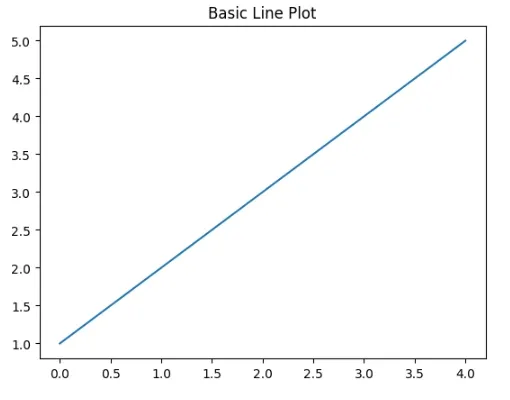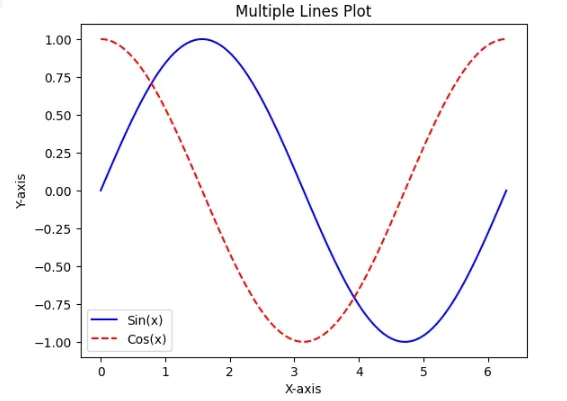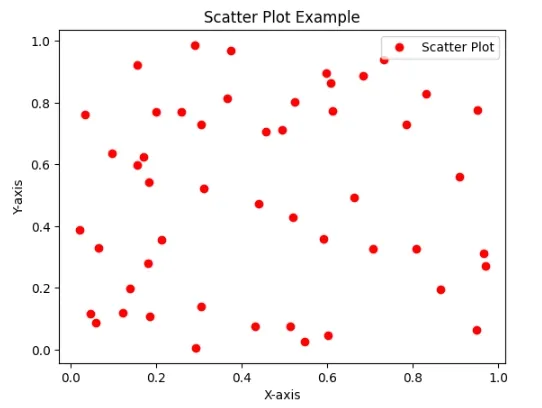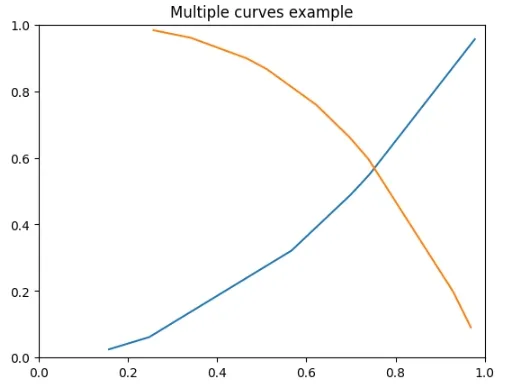Matplotlib.pyplot.plot() function in Python (original) (raw)
Last Updated : 26 Apr, 2025
The **matplotlib.pyplot.plot() is used to create 2D plots such as line graphs and scatter plots. The **plot() function allows us to plot data points, customize line styles, markers and colors making it useful for various types of visualizations. In this article, we’ll see how to use this function to plot data in Python.
**Syntax: matplotlib.pyplot.plot(*args, scalex=True, scaley=True, data=None, **kwargs)
**Parameters:
- **x, y: Represent horizontal and vertical coordinates for the data points.
- **fmt: A format string that defines the line style, marker and colour.
- **data: The optional parameter can be an object containing labelled data which makes it easier to handle datasets directly.
**Returns: A list of Line2D objects each representing a segment of the plotted data.
There are many ways of creating plot using **Matplotlib.pyplot.plot() function some of their examples are:
**Example 1: Line Plots in Matplotlib
Here we use Matplotlib‘s **plot() function to create a simple line plot with the data [1, 2, 3, 4, 5].
Python `
import matplotlib.pyplot as plt plt.plot([1, 2, 3, 4, 5]) plt.title('Basic Line Plot') plt.show()
`
**Output:

Basic Line Plot
**Example 2: Multiple Lines Using Matplotlib
We will plot sine and cosine functions on the same graph.
- **plt.plot(x, y1, label=’Sin(x)’, color=’blue’): Plots sine curve with x values and y1 values labeling it as “Sin(x)” and using a blue color for the line.
- **plt.plot(x, y2, label=’Cos(x)’, color=’red’, linestyle=’–‘): Plots cosine curve with x values and y2 values labeling it as “Cos(x)” using a red color and a dashed line style. Python `
import matplotlib.pyplot as plt import numpy as np x = np.linspace(0, 2 * np.pi, 100) y1 = np.sin(x) y2 = np.cos(x) plt.plot(x, y1, label='Sin(x)', color='blue') plt.plot(x, y2, label='Cos(x)', color='red', linestyle='--') plt.xlabel('X-axis') plt.ylabel('Y-axis') plt.title('Multiple Lines Plot') plt.legend() plt.show()
`
**Output:

Multiple Lines Plot
**Example 3: Scatter Plot with Custom Markers
We will generate and customize scatter plot with 50 random data points featuring red circular markers.
- **plt.plot(x, y, marker=’o’, linestyle=”, color=’red’, label=’Scatter Plot’): Plots a scatter plot with x and y values and using red circular markers (marker=’o’) with no connecting lines (linestyle=”) and labeling it as “Scatter Plot”. Python `
import matplotlib.pyplot as plt import numpy as np np.random.seed(42) x = np.random.rand(50) y = np.random.rand(50) plt.plot(x, y, marker='o', linestyle='', color='red', label='Scatter Plot') plt.xlabel('X-axis') plt.ylabel('Y-axis') plt.title('Scatter Plot Example') plt.legend() plt.show()
`
**Output:

Scatter Plot with Multiple Markers
**Example 4: Plotting Multiple Curves
We are creating a line plot with two curves: a blue curve [Tex]y = x^2[/Tex]and an orange curve [Tex]y = 1 – x^3[/Tex] generating data randomly. The plot is limited to the range [0, 1] on both axes showcasing a visual representation of mathematical functions.
Python `
import matplotlib.pyplot as plt import numpy as np np.random.seed(19680801) xdata = np.random.random([2, 10]) xdata1 = xdata[0, :] xdata2 = xdata[1, :] xdata1.sort() xdata2.sort() ydata1 = xdata1 ** 2 ydata2 = 1 - xdata2 ** 3 plt.plot(xdata1, ydata1, color ='tab:blue') plt.plot(xdata2, ydata2, color ='tab:orange') plt.xlim([0, 1]) plt.ylim([0, 1]) plt.title('matplotlib.pyplot.plot() example 2') plt.show()
`
**Output:

Two Curves Plot
With the flexibility to customize line styles, markers and colors Matplotlib’s plot() function provides various possibilities for visualizing our data in Python.